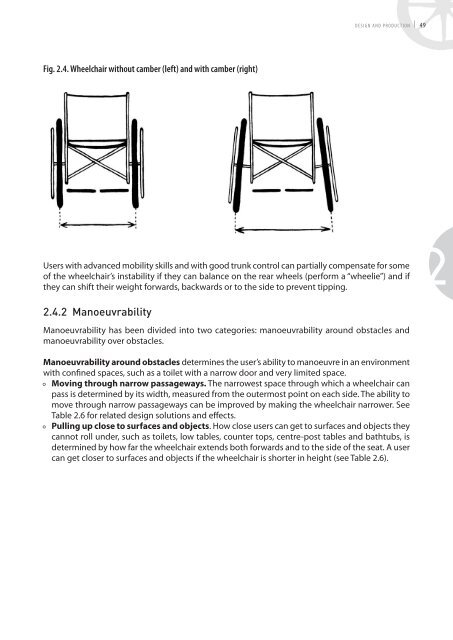Manual Wheelchairs - World Health Organization
Manual Wheelchairs - World Health Organization
Manual Wheelchairs - World Health Organization
Create successful ePaper yourself
Turn your PDF publications into a flip-book with our unique Google optimized e-Paper software.
Fig. 2.4. Wheelchair without camber (left) and with camber (right)<br />
desIgn and productIon I 49<br />
Users with advanced mobility skills and with good trunk control can partially compensate for some<br />
of the wheelchair’s instability if they can balance on the rear wheels (perform a “wheelie”) and if<br />
they can shift their weight forwards, backwards or to the side to prevent tipping.<br />
2.4.2 Manoeuvrability<br />
Manoeuvrability has been divided into two categories: manoeuvrability around obstacles and<br />
manoeuvrability over obstacles.<br />
Manoeuvrability around obstacles determines the user’s ability to manoeuvre in an environment<br />
with confined spaces, such as a toilet with a narrow door and very limited space.<br />
• Moving through narrow passageways. The narrowest space through which a wheelchair can<br />
pass is determined by its width, measured from the outermost point on each side. The ability to<br />
move through narrow passageways can be improved by making the wheelchair narrower. See<br />
Table 2.6 for related design solutions and effects.<br />
• Pulling up close to surfaces and objects. How close users can get to surfaces and objects they<br />
cannot roll under, such as toilets, low tables, counter tops, centre-post tables and bathtubs, is<br />
determined by how far the wheelchair extends both forwards and to the side of the seat. A user<br />
can get closer to surfaces and objects if the wheelchair is shorter in height (see Table 2.6).<br />
2

















